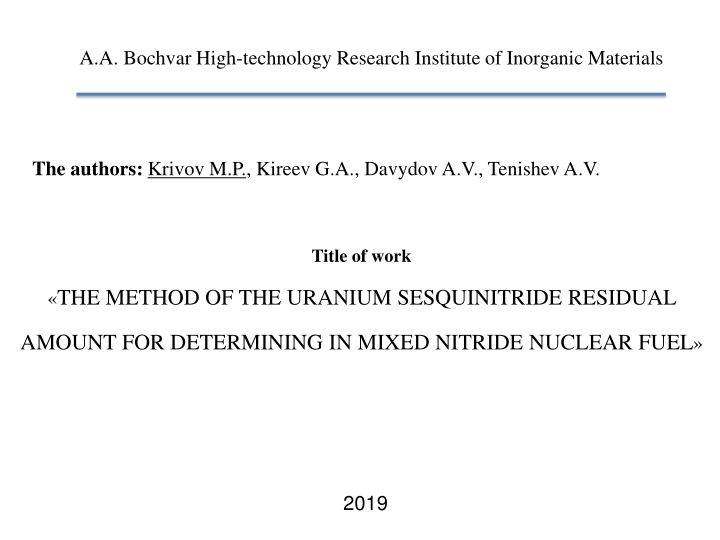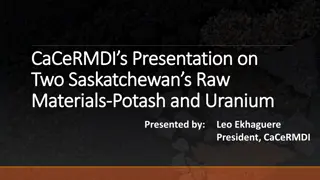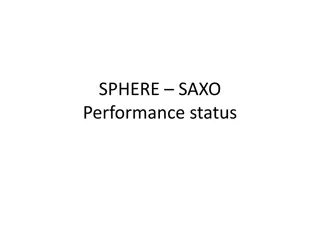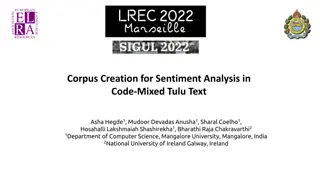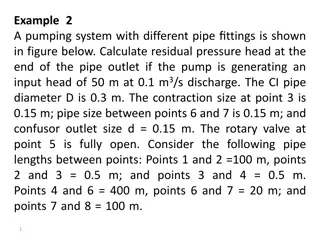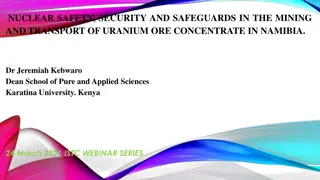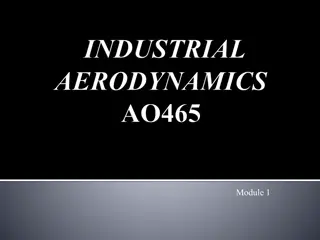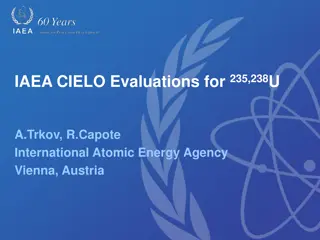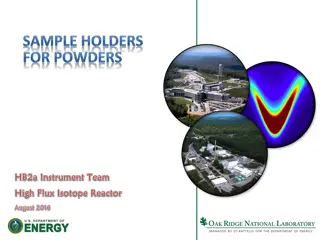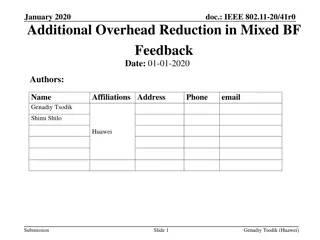Method of Uranium Sesquinitride Residual Amount Determining in Mixed Nitride Nuclear Fuel
A study conducted at A.A. Bochvar High-technology Research Institute of Inorganic Materials explores the method of determining the residual amount of uranium sesquinitride in mixed nitride nuclear fuel. The research involves investigating different nitrides obtained through carbothermic synthesis, analyzing the composition of uranium mononitride and MNIT fuel, and studying the thermogravimetric data of various uranium nitrides. The existence of multiple phases of uranium nitrides is revealed, along with their decomposition under different conditions.
Download Presentation

Please find below an Image/Link to download the presentation.
The content on the website is provided AS IS for your information and personal use only. It may not be sold, licensed, or shared on other websites without obtaining consent from the author.If you encounter any issues during the download, it is possible that the publisher has removed the file from their server.
You are allowed to download the files provided on this website for personal or commercial use, subject to the condition that they are used lawfully. All files are the property of their respective owners.
The content on the website is provided AS IS for your information and personal use only. It may not be sold, licensed, or shared on other websites without obtaining consent from the author.
E N D
Presentation Transcript
A.A. Bochvar High-technology Research Institute of Inorganic Materials The authors: Krivov M.P., Kireev G.A., DavydovA.V., TenishevA.V. Title of work THE METHOD OF THE URANIUM SESQUINITRIDE RESIDUAL AMOUNT FOR DETERMINING IN MIXED NITRIDE NUCLEAR FUEL 2019
Nitride dissociation Oxide fuel : UO2. Tmelt(UO2)= 2805 C Nitride fuel UN(s) U(l) + 1/2N2 Tdiss(U) = 1132 oC; Tdiss 1800 PuN(s) PuN(g) Pu(l) + 1/2N2 diss no data Tmelt(Pu) = 640 oC; (UPu)N ? 2
Equipment and research methods Thermal analysis: thermogravimetry (TG); Mass spectrometry; Additionally: chemical analysis. 4
Investigated samples Nitrides that was obtained by carbothermic synthesis: UN; PuN; (U1- Pu )N. (Pu)=5,9; 9,8; 12; 14; 20 50 .% msample 50-500 mg. Nitrogen content 5,2-5,6 wt.%. 5
Uranium mononitride Composition: N 5,368 wt.%, 0,208 wt.%, 0,316 wt.%. U2N3 2,39 wt.% Results of a thermogravimetric study of uranium nitride at the temperature of 1900 and 2100 6
MNIT fuel (U0,902Pu0,098)N Composition : 0,104 wt.%, N 5,54 wt.%, 0,137 wt.%. U2N3 4,55 wt.% Results of a thermogravimetric study of MNIT fuel (U0,902Pu0,098)N at the temperature of 1900 7
Thermogravimetric data PuN 1800 8
Uranium sesquinitride The existance of four phases of uranium nitrides was revealed in the uranium-nitrogen system: UN, cubic -U2N3, hexagonal -U2N3, UN2- Cubic -U2N3 has composition UN1,54 UN1,75 Hexagonal -U2N3 has composition UN1,45 UN1,49 The - phase transition occurs above 800 . The decomposition of sesquinitride at a nitrogen pressure of 1 atm occurs at the temperature of 1300 [1]. The decomposition of higher uranium nitrides in a vacuum occurs as follows [2]: Uranium mononitride (UN) content 5,56 wt.% nitrogen [1]. Kurosaki K. et al. A molecular dynamics study on plutonium mononitride //Journal of alloys and compounds. 2000. . 313. . 1-2. . 242-247 [2] Wang X. et al. Study of the Decomposition and Phase Transition of Uranium Nitride under UHV Conditions via TDS, XRD, SEM, and XPS //Inorganic chemistry. 2016. V. 55. . 21. P. 10835-10838. 9
Determination of the composition of MNIT fuel by thermogravimetry The level of nitrogen and carbon, oxygen impurity absorption method using the for sample nitride fuel (U0,941Pu0,059)N: was determined by the infrared Comparison of calculated and experimental data on the mass loss of mixed nitride in the low-temperature area 0,034 wt.%; N 5,51 wt.%; The estimated Weight loss Expected 0,145 wt.%. content of the from TG weight loss, phase U2N3in the sample, wt.% experiments, mg mg (UPu)N 96,49 wt.%; 0,05 0,01 0,08 0,03 1 (UPu)O2 0,29 wt. %; 1,84 0,11 0,01 0,2 0,08 2 (UPu)C2 1,37 wt.%; 0,06 0,01 0,08 0,03 3 U2N3 1,84 wt.%. 10
MNIT fuel (U0,88Pu0,12)N Composition : N 5,36 wt.%; 0,07 wt.%; 0,07 wt.%. According analysis, (U2N3) must be absent. to sesquitnitride chemical Results of a thermogravimetric study of MNIT fuel (U0.88Pu0.12) N, at the temperature of 1900 C 11
MNIT fuel (U0,86Pu0,14)N Composition : 0,101 wt.%, N 5,45 wt.%, 0,136 wt.%. U2N3 0,95 wt.% Results of a thermogravimetric study of MNIT fuel (U0,86Pu0,14)N, at the temperature of 1900 12
Sesquinitride According to the specification of the tablet MNIT fuel: N 5,2-5,6 wt.%; and 0,15 wt.% each. According to calculations of the phase composition at the maximum allowable concentration of oxygen and carbon impurities and nitrogen content at the upper boundary, the nitride fuel can contain up to 8.06 wt.% of the phase U2N3 13
The distribution of maximum fuel temperature at the height of the reactor core 14
Findings It has been shown that mixed nitride and uranium nitride have started to lose mass at much lower temperatures, than the melting point. The loss of mass occurs in several stages. At the same time, the mass loss at the first stage (800-1400 ) is small. At the second stage, above the temperature of 1700 , fuel decomposition occurs. Mass loss in the low-temperature area (800-1400 ) is associated with the decomposition of residual sesquinitride, which can be formed in nitride fuel during its fabrication. In this case, the thermogravimetry method established that the decomposition of sesquinitride takes place in 2 stages for MNIT fuel and in the 1 stage for uranium nitride. Based on the results of thermogravimetric analysis and mass spectrometry, a method was offered for determining the amount of U2N3in the nitride fuel. 15
